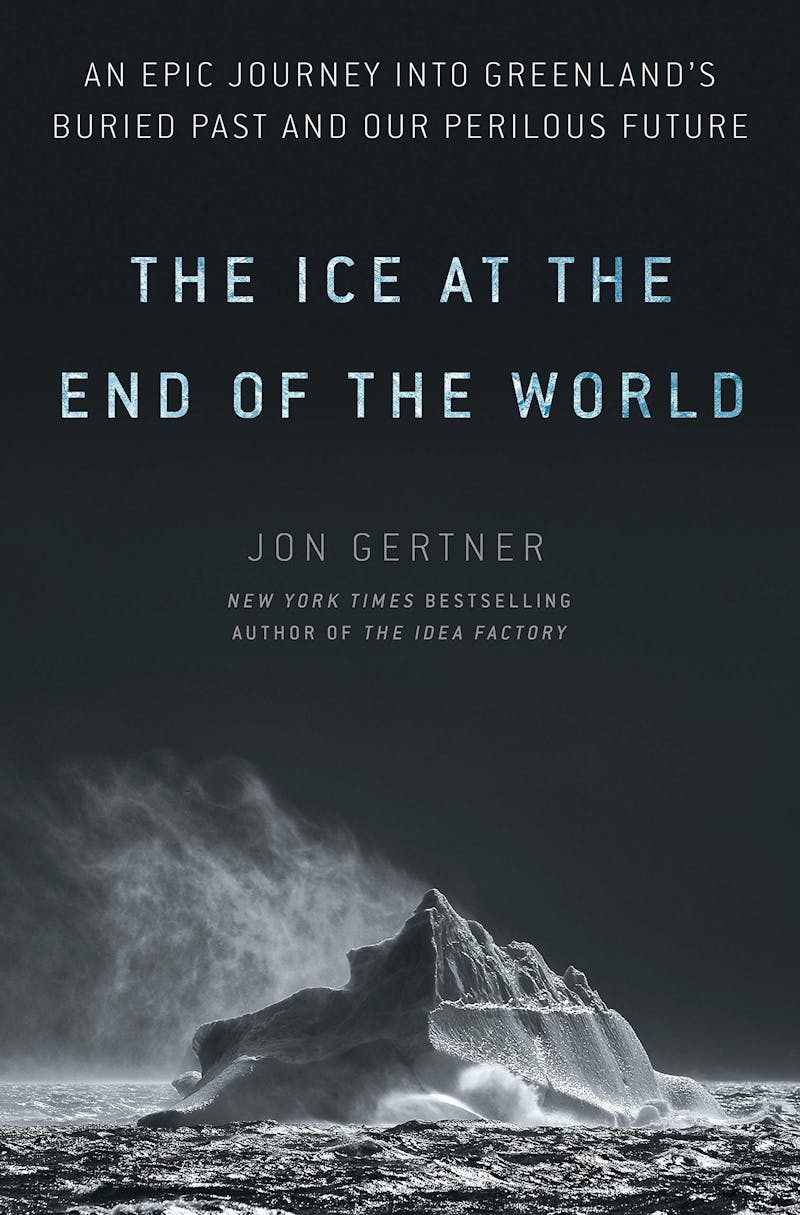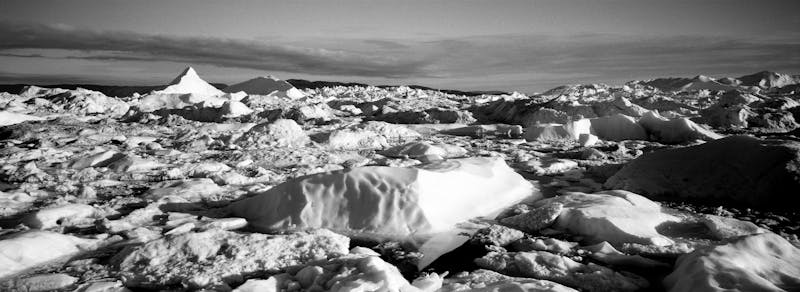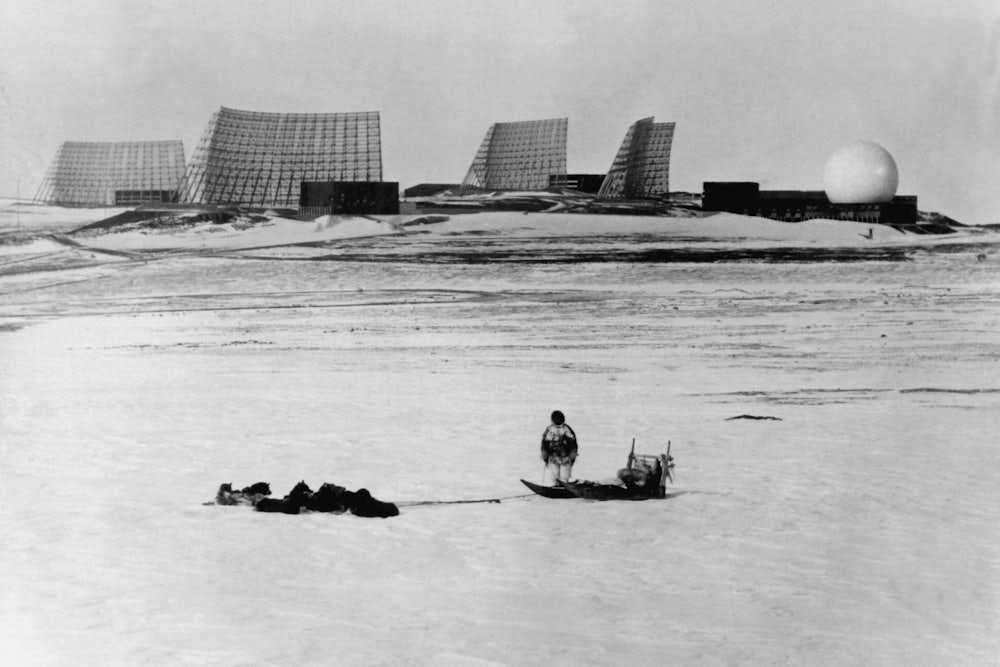There are two major kinds of Arctic narratives. There are those of heroic and doomed adventurers, and there are the environmental stories. In one class are books like Hampton Sides’s In the Kingdom of Ice or Anthony Brandt’s The Man Who Ate His Boots—books in which the Arctic is terrifying, destructive, a thing to be fought and conquered, in which man (it’s always a man) falls victim to the rampages of the ice and wind. The other Arctic appears in books like Gretel Ehrlich’s The Future of Ice or Marla Cone’s Silent Snow, vulnerable, dying, itself a victim of the rampages of man. These two Arctics are at odds with one another, pushing diametrically opposed narratives: We can either see a place of forbidding, exotic danger, or a place endangered by our reckless existence.

Jon Gertner’s book The Ice at the End of the World: An Epic Journey Into Greenland’s Buried Past and Our Perilous Future proposes to combine both strands, telling the story of Greenland in two broad halves. The first is a mostly nineteenth- and early twentieth-century history of European and American explorers, and the first successful attempts to cross the continent. The second half is a largely post–World War II history, of scientists who’ve returned to Greenland not to conquer it but to study it, to delve into its glaciers to unlock an epochal history of climate, and to use this to better understand where we’re headed in these uncertain days.
Greenland has always been a deceptive place, a landscape, the geologist Ernst Sorge wrote in the early 1930s, “whose vast simplicity is nowhere to be surpassed on earth, and which yet conceals a thousand secrets.” It has very few inhabitants, no major cities, no well-known mountains or rivers or anything distinguishing—it only has ice. Endless, seemingly undifferentiated ice, a cap of glaciers covering the entire island. And yet, as explorers found when they tried to cross it, and as scientists found when they started looking at it, that ice is in fact constantly shifting, moving, reforming—and, most importantly, keeping track of our climate and our history, locking the past within its glaciers. By pairing overland adventurers and scientific pioneers, Gertner tells the story of how Europeans and Americans initially overestimated the island’s simplicity, as well as how we came to recognize these manifold secrets, which climatologists are still teasing out of the ice and rock.
For much of the nineteenth century, Greenland was a tantalizing destination for explorers who hoped to win fame, but the first person to seriously undertake a crossing of the island was the Norwegian Fridtjof Nansen, who made the journey in 1888. Until Nansen, most explorers had tried to cross from west to east, from the inhabited side of the island to its forbidding Atlantic coast. But that coast was beset with dangerous ice floes, and Nansen devised a plan, what he called “the scheme of a lunatic,” to land amid those crushing icebergs, fight his way to shore, and then cross to the inhabited towns on the west coast. (It was these counterintuitive—but successful—ideas that Nansen was known for: Later in life he’d attempt the North Pole not by trying to sail there directly, but by building a ship purposely meant to get caught in the ice, counting on ocean currents to carry his icebound ship close enough to the pole to make an overland attempt.)
Nansen believed that “Every single section of earth’s surface stands in intimate and reciprocal relation to its neighbors,” and he stands out for not only his cunning and daring, but his understanding that even the most ferocious places on Earth are vital to our survival. (Nansen, after his exploring days were through, would later reinvent himself as a humanitarian, winning the Nobel Peace Prize in 1922 for his work on behalf of stateless refugees.)

The man who followed (begrudgingly, angrily) in his footsteps could not have been a sharper contrast. When Robert Peary heard the news that Nansen had crossed Greenland, he looked, according to his wife, “as if he had just seen someone die.” Peary, constantly lusting for fame and glory, had hoped to win that prize for himself, and had to console himself instead with an attempt to cross the northern coast—a more difficult feat than Nansen’s, and one that would prove, once and for all, that Greenland was an island, and not connected to some as-yet-unknown landmass further up in the Arctic. Peary, Gertner writes, was ruthless in his exploitation of local families—“ruthless not only in what he sought in service to his goals of exploration, but in what he sought for his personal appetites and his imperial desire for control.” As one Inuit recounted in 1967, Peary once had a barrel’s worth of biscuits strewn about a beach, solely to amuse himself as he watched his Inuit friends scramble about to pick them up and eat them.
As the book moves forward into the twentieth century and the era of scientific inquiry, it simultaneously begins moving backwards, by tens of thousands of years, as researchers began to understand that Greenland’s glaciers could be used to read the ancient past.
Paul-Émile Victor had followed in Nansen and Peary’s footsteps, making overland expeditions of Greenland in the 1930s, but it was his work after World War II that would change how humanity understood the island. After the war, he succeeded in cobbling together funding for a French research base in Greenland, and in 1951 he made a startling discovery. His team had been drilling down into Greenland’s ice, removing core samples from five hundred feet down. They soon realized that they could measure the temperature and density inside this older ice, and that this, in turn, could be used to learn what the Earth’s climate had been like when this ice was first locked in the glacier. After Victor’s team dug a well 100 feet deep and three feet in diameter, Victor rappelled down, heading backward in time. “Here before my eyes,” he later said of this deep, compacted snow, “was the record of much more than a century of its history.” Just as a tree’s rings could be read for clues of the past, so too could Greenland’s ice; the difference being that a tree could go back only centuries, whereas with Greenland’s ice you could go back millennia.
From that point, Greenland’s future became about documenting our climate’s history. Ice core samples offer an extraordinarily detailed look into the planet’s climatological past; they can be used to document climate and weather, as well as humanity’s impact (Greenland’s ice, for example, bears traces of lead from the Roman Empire). The glaciers offered a wealth of data to any scientist with a drill and the means to get out there.
Much of the early work in this area was inadvertently midwifed by a third party: the United States military. The American government began to see strategic potential in Greenland; as historian Ronald Doel explained, “Greenland loomed large in the American psyche in the late 1940s, because the U.S. felt newly vulnerable to the Soviet Union, especially in the north, a part of the world it knew little about.” Now they came back to its glaciers—not as lone explorers but as literal armies, establishing first Thule Air Force Base, on the island’s northwest corner, and then building a hidden base in its interior, Camp Century.
Thule, Gertner writes, “was an outpost conceived in paranoia and dressed gaudily in propaganda.” And its implementation in the summer of 1951 was extensive: 120 ships carrying some 8500 men along with a small city’s worth of building material, a logistical operation as massive and complicated as the Normandy landing. But this was nothing compared to Camp Century, established in 1959, 140 miles inland. Ostensibly a research outpost, Camp Century was in fact a secret military installation, powered by a small nuclear reactor. Beneath the surface of the glaciers, engineers hoped to tunnel out a series of railways that would eventually cover an area as large as the state of Alabama; on these they would store some 600 intercontinental ballistic missiles trained at the Soviet Union, kept in constant motion on the tracks to avoid detection. The idea was a mix of folly and insanity—as is obvious now and should’ve been obvious then. But Greenland emerges through each chapter of The Ice at the End of the World as a place constantly misunderstood: a place tantalizing with untapped information and strategic value, and yet one that is so foreign to our understanding of the world that we cannot help but be stymied by it.
Camp Century did have one positive side effect, though—the presence of such a vast military apparatus set up to overcome weather and logistical difficulties allowed for genuine scientific research to advance exponentially, finally unhindered by the elements. At Camp Century, researcher Henri Bader began an ambitious project to drill down through the glacier to Greenland’s bedrock, retrieving core samples along the way, creating a library of ice. Using new drilling technology and relying on the military’s infrastructure to keep the site stable and safe, researchers were finally able to hit bedrock—at 4,450 feet—in 1966.
Yet Camp Century couldn’t last forever. Its infrastructure wasn’t all that reliable. Glaciers don’t just sit there on the surface; they constantly move (however glacially), grinding against each other, deforming and reforming. The camp, built under the surface of Greenland’s glaciers, was subject to enormous (literal) pressure: Workmen removed up to 40 tons of ice a week to keep passageways clear. It was a losing battle. The same year that scientists hit bedrock, the military pulled out. They removed the nuclear reactor and other important material, but left most of Camp Century to be ground up by the glaciers and locked in the ice forever.
As the military gave up, the scientific establishment had to find new ways to fund their Greenland experiments, relying increasingly on university research labs. They began to understand more and more about the Earth’s history through the island’s glaciers and the core samples they removed. In 1981, a second complete core sample confirmed what Bader’s earlier Camp Century work had suggested: that the planet had seen in its past wild climate shifts, and that, in Gertner’s words, “Earth’s climate had no problem changing quickly and furiously, regardless of human expectations.”
Soon the island had other stories to tell. In 1997, NASA greenlit a project called Gravity Recovery and Climate Experiment (GRACE), which would use two satellites to measure the weight of Greenland’s glaciers from space by reacting to slight changes in the gravitational pull over the ice. Launched in 2002, GRACE soon began returning data that pointed to a cold, blunt fact: Greenland was losing over a hundred billion tons of ice each year, and that number was climbing. Gertner does not mince words; within a few decades, he notes, the collapse of the ice sheets in Greenland and Antarctica will cause a “terrible epoch of human dislocation and economic hardship.”
By the time The Ice at the End of the World nears its conclusion, a bleak assessment of the future sprinkled with small bits of hope, the subjects of the book’s first half have completely disappeared. There’s not much mention of Peary, Nansen, or the other early explorers in the book’s second half, and not much of an attempt to bind the two unwieldy halves of the book together. “In some respects,” Gertner offers, “field experiments to retrieve deep ice cores soon became like ice sheet expeditions without the dogs or the roving or the hunger. Rather than pursuing the vision of a charismatic leader, though, you were exploring an idea—seeking clues, in effect, to construct an understanding of the vanished earth.” This is an OK sentence, but once you try to work out the comparison it falls apart: A sound scientific idea is not really anything like a charismatic leader bent on glory, and a massively funded, technologically advanced team has little in common with small groups of men struggling against the elements.
Another problem with Gertner’s book is his general lack of interest in the Inuit people whose relationship with Greenland long predates Europeans and Americans. While the subtitle promises the reader Greenland’s “buried past,” by starting with Nansen and other explorers, Gertner’s story writes off some 4,500 years of earlier history and human habitation. It’s not that he’s unsympathetic to the native Greenlanders—indeed, when describing Peary’s interactions with them he treats them with sympathy and understanding. But even there, the original inhabitants of Greenland are nothing more than foils to white men; they don’t seem to deserve their own role in this telling of Greenland’s history.
But what the first half of the book does allow Gertner to do is to treat the scientists of the second half with the same narrative gusto as Nansen and Peary. The evolution of the ice core hypothesis, the refinement of the techniques, and the gradual, stunning lessons learned by analyzing them, is a fascinating, compelling story that could have survived on its own without the earlier age of exploration. It is refreshing to read an actual history of climatology, and see how the succession of technological advances, accruing data, and new perspectives turned a hypothesis into solid data.
If there is any kind of connection between the two halves of The Ice at the End of the World, it’s in the way in which humans act when faced with our own mortality. What makes Arctic adventure narratives so readable are their depictions of people pushed to the extremes, facing likely death, and how ordinary and extraordinary individuals respond in such moments. Climate scientists, too, are now engaged in understanding a different life-and-death struggle, one that involves our whole species. How each of us will respond remains to be seen, but it seems clear that very soon we may not have to venture to the remote Arctic in order to come face to face with doom.
